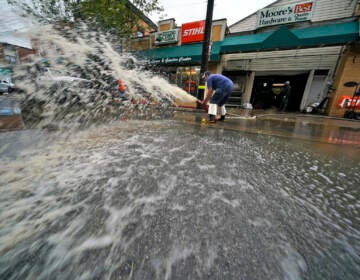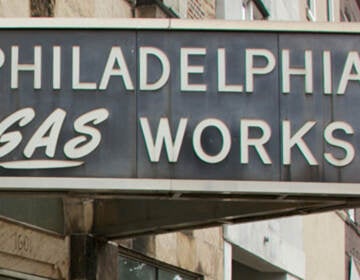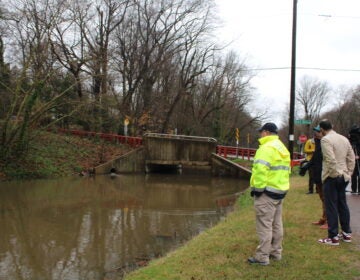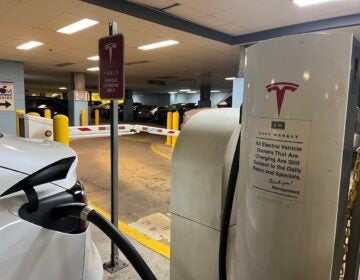Why Ida’s remnants left the Vine Street Expressway under water
A pump system, designed in the 1970s, lost power during Hurricane Ida. But it didn't have much of a chance to begin with.
Listen 4:18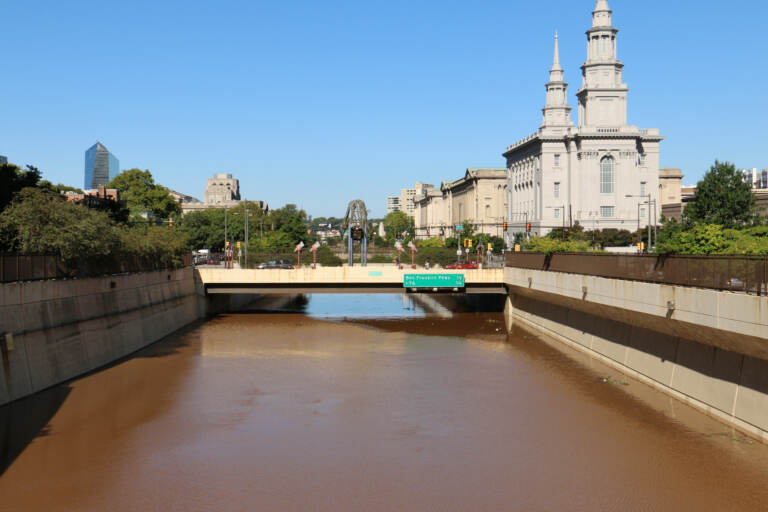
The Vine Street Expressway is filled like a bathtub from Broad Street to the Schuylkill River after torrential rain from the remnants of Hurrican Ida in September 2021. (Emma Lee/WHYY)
This story is part of the WHYY News Climate Desk, bringing you news and solutions for our changing region.
From the Poconos to the Jersey Shore to the mouth of the Delaware Bay, what do you want to know about climate change? What would you like us to cover? Get in touch.
Over a year ago, the Vine Street Expressway, or I-676, looked more like a canal than the highway that runs through Center City.
A depressed portion of the roadway filled like a bathtub with floodwaters from the swollen Schuylkill River, as the remnants of Hurricane Ida moved through the Philadelphia region. It took days for the highway, which connects I-95 and the Schuylkill Expressway, to fully reopen in both directions.
“You could’ve swam from 22nd Street to about 15th Street,” said Justin Galbreath, a district maintenance manager at the Pennsylvania Department of Transportation.
The reason, according to PennDOT: a vital pumping station was overwhelmed.
Submerged electrical equipment
PennDOT operates four pumping stations in the city of Philadelphia to keep roadways dry: two near the Delaware River that service I-95 and an offramp to Christopher Columbus Boulevard, and two along the Vine Street Expressway — one near 10th Street and the other beneath 22nd Street. It was the pump station at 22nd Street, closer to the Schuylkill River, that failed during Ida.
Both the equipment connecting this pumping station to the PECO electricity supply and a backup generator are located at the same level as the sunken Vine Street Expressway, about 18 feet below the 22nd Street overpass, according to PennDOT officials.
As the roadway filled with floodwaters, that became a problem.
“The water continued to rise and continued to rise,” Galbreath said. “At a certain point, the power supply — our PECO power supply and our generator — went underwater.”
Without power, the pumps could not function.
“Just like what you saw in [Hurricane] Katrina … when you have that bathtub effect, those low points, the water can’t get out without a pump,” said Virginia Smith, a professor at Villanova University’s Center for Resilient Water Systems, which PennDOT hired as a research partner on the agency’s long-term improvement project along I-95. “Once something fails, it’s just going to keep getting worse.”
The flooding of the Vine Street Expressway and 22nd Street pump station during Ida caused around $715,000 in damage, according to PennDOT spokesperson Brad Rudolph. PennDOT had to replace the electrical equipment at the pump station, Galbreath said, but the pumps themselves were able to be repaired.
Widespread inundation: ‘You’re just putting it back where it’s coming in from’
Even if the pumping station had maintained power, the Vine Street Expressway still would have flooded, said Tim Stevenson, assistant district executive for project delivery at PennDOT.
The limiting factor on how fast the pumps can work is the 20-inch-wide pipe that carries water away from the roadway, Stevenson said. During Ida, it was just too small.
If the pumps had continued functioning, “there still would have been significant flooding on 676, but perhaps it wouldn’t have been flooded for as long,” Stevenson said.
Maybe the biggest problem of all was the fact that the pipe discharges back to the Schuylkill River, which had inundated not only I-676, but large swaths of the surrounding neighborhood along the river.
“Currently where [the pipe] outlets is to the river,” Stevenson said. “You can force the flow, but you’re just putting it back where it’s coming in from.”
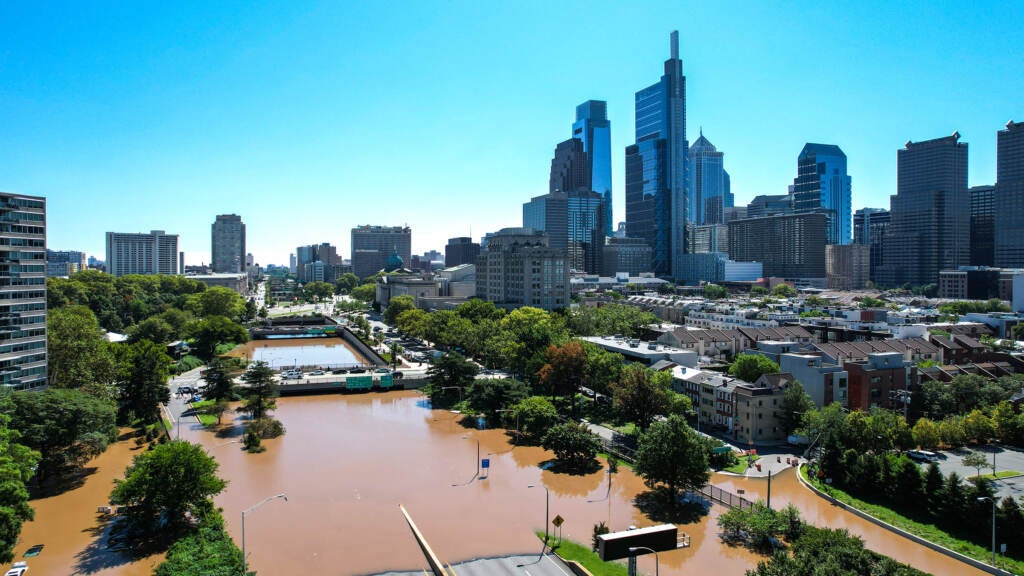
A pump not designed to handle flooding from the river
The 22nd Street pumping station was designed in the 1970s, Stevenson said, to drain stormwater that falls over a few blocks of the highway east of 23rd Street, not flooding from the Schuylkill River to the west.
Flooding in Philly could get worse with climate change, as a warmer atmosphere holds more moisture. Heavy rain is already becoming more intense and more frequent in the U.S., particularly in the northeast — and this trend is expected to continue. On the Schuylkill River specifically, the city of Philadelphia expects the “depth and extent” of flooding to increase.
During Ida, the Schuylkill River reached the highest level recorded at a stream gauge near the Philadelphia Zoo since the gauge started operating in 1931, said Marla Stuckey, a hydrologist with the U.S. Geological Survey’s Pennsylvania Water Science Center. The river crested at 16.35 feet last September, second only to a 17-foot peak estimated in 1869. The river is considered to be in “major flood stage” when it reaches 15.5 feet.
“[I-676] is an older road, and what we’re finding is our weather patterns are changing,” said Robert Traver, professor and director of the Villanova Center for Resilient Water Systems. “We’re getting more intense flooding, and basically we need to update to bring ourselves up to the current weather conditions. The systems weren’t designed for the flows we’re getting now.”
Another problem, Traver said, is the development of more “impervious surfaces,” like pavement and buildings, that cause falling rain to run off into storm drains and streams, rather than soak into the ground.
“So all of a sudden now, because we’re getting more water running off … the pavement, we’re getting more rainfall by itself and higher intensity rainfalls, then all these designs that were built for a certain level of performance are now … going to be flooded more often,” he said.
Recent upgrades did not help
The electrical equipment and pumps at the 22nd Street pumping station were just about a year old when Ida hit, according to PennDOT’s Stevenson.
That’s because of a $32.6 million modernization project in which PennDOT replaced aging equipment in the four Philly pump stations and one in Bucks County, from 2017 to 2021.
The goal of the project was to update old equipment that had become unreliable, Stevenson said. It did not include raising equipment up higher or expanding the discharge pipe.
PennDOT did improve the redundancy of the 22nd Street pump station during the project, replacing the station’s three pumps with larger ones, so that only two need to run for the station to work at full capacity, while the third acts as a backup. But the modernization project largely rebuilt the pumping station as it was originally designed, Stevenson said.
“We pretty much replace the equipment at location, from what it was,” he said.
However, PennDOT was aware of I-676’s vulnerability to flooding. The portion of the expressway between the Schuylkill River and 15th Street ranks among the top 10% to 1% most historically flood-vulnerable PennDOT road segments, in an extreme weather vulnerability study the agency published in 2017 and updated in 2019.
This is no surprise, given the Vine Street Expressway’s location and elevation.
“If you have low-lying areas, like you have the dip in I-676, or if you’re crossing water where you have a risk of … a waterway overtopping its banks, that’s where you see the biggest risks,” said Virginia Smith, of Villanova.
A plan to prevent future pump failures
PennDOT is working on improving the Vine Street Expressway’s pump system to reduce the risk of future floods like Ida. But renovations are likely still years away.
PennDOT is commissioning a study to further explain why the 22nd Street pump station failed and to make recommendations for how to protect this station, and possibly another a few blocks east.
The study will explore the behavior of the Schuylkill River during Ida and, notably, model future flood risk from the river — a relatively new endeavor for PennDOT.
“We’ve got to harden our assets,” PennDOT spokesperson Brad Rudolph said. “Climate change is no joke.”
Stevenson, with PennDOT, said solutions to protect I-676 could include elevating pump station equipment, building a “river wall” or a “pop-up dam.”
Traver, of Villanova, said the “obvious” answer would be to increase pumping capacity by adding “more pipes and more inlets.”
“But also maybe there is something you can do to stop the water from getting to it,” he said. “Where is that water coming from? … There might be something you would do upstream that would solve the problem.”
This might look like more green stormwater infrastructure to absorb runoff, Traver said, or something that would divert water to another location.
Ben She, an organizer with the urbanist PAC 5th Square, hopes the flooding of I-676 motivates officials to look at the resiliency of other infrastructure — for example, the pumps that keep Philly’s subway system dry.
“This pump … maybe it might be like a harbinger of what’s to come,” he said.
WHYY is your source for fact-based, in-depth journalism and information. As a nonprofit organization, we rely on financial support from readers like you. Please give today.





